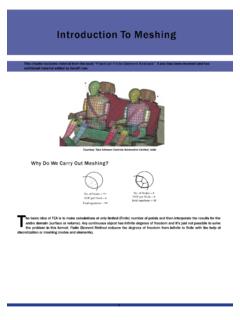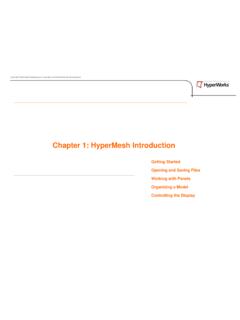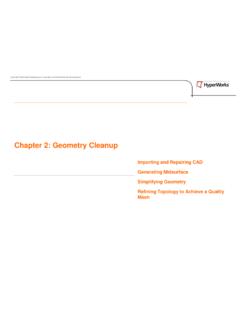Transcription of -Post-Proce ssing - Post-Processing - Altair University
1 -Post-ProcePost-ProThis chapter includes material from the book Practical Finadditional material added by Kristian Holm, Hossein ShakourzPlease note that this chapter is mostly intended for post-processrelevant for crash or nonlinear To Validate And Check Accuracy Of TFinite Element Analysis is an approximate technique. The levelwith respect to the experimental data. The following checks hFEA AcComputational Accuracy1) Strain energy norm, residuals2) Reaction forces and moments3)Convergence test)g4) Average and unaverage stress difference Visual check Discontinuous or an abrupt change in the strefor local mesh refinement in the region. 10to 15% difference inFEA and experimental results is cons10to 15% difference inFEA and experimental results is cons Probable reasons for more than 15% deviation wrong bostresses, localized effects like welding, bolt torque, experimenComputational accuracy does not guarantee the correcmay still behave in a different way in reality, than what sresults or approval of the results by an experienced CAEsimilar product / component over the years)
2 Is necessathe quality of mesh and the deviation of the mathematassumptionsassumptionsHowToViewA ndInterpretResultsImportant Rule Of ThumbAlwaysviewthedisplacementandanimati onfordeformationfir1 Alwaysviewthedisplacementandanimationfor deformationfircloseyoureyesandtrytovisua lizehowtheobjectwoulddeformsoftware should match with this. Excessive displacement or illogicessing -ocessingite Element Analysi s . It also has been reviewed and has zadeh and Matthias of linear analysis results. Not all the comments made are The Resultof accuracy of the displayed results could be 25%, 60%, or 90%helps in reducing the error marginccuracyCorrelation with actual testing1) Strain gauging -Stress comparison2) Natural frequency comparison3) Dynamic response comparison4) Temperature and pressure distribution comparisoness pattern across the elements in critical areas indicate a needsidered a good correlationsidered a good correlationoundary conditions, material properties, presence of residualntal errors of the Finite Element Analysis ( the componentsbeing predicted by the software).
3 Correlation with testE/ Testing department engineer (who has worked on aary. One has to distinguish between the FE error due toticalmodel to the physical problem related to modelingrst, , the given loading conditions. The deformation given by thecal movement of the components indicate something is displacements shown in the plot below is exaggerated tobdisplacement might not be visible at all due to a very small magnto display scaled results (without actually changing the magnitudeAbove: Displacement contour plot; dAn extremely useful visualization technique is to animate resulresults from a static analysis. The animated motion of the modeldue to the applied loads (and constraints).Check Reaction Forces, Moments, Residuals And Strain EnCigthtifli dftdComparingthe summation ofappliedforces ormomentsandreresiduals helps in estimating the numerical accuracy of the resuactivated by selecting Check > Loads Summary (under the OptiStr2essing (scalefactor= )nitude.)))
4 Therefore, most of the post processors provide the abilityeofthe results).isplacements scaled by factor This option is also (and especially) useful while interpretingprovides insight into the overall structural response of the systemnergy Normstifttlditlkddactionforces ormoments, externalandinternalworkdone, andults. The values should be within the specified limits. This can beruct UserProfile).-Post-ProceThe following summary table about the applied loads can be outpResults data such as SPCFORCE etc. must be requested through thThen, in the corresponding *.out file the following summary is proStress PlotThe location and contour in the vicinity of the maximum stresssin the stress pattern across the elements in critical area indicatevarious options for stress, like nodal, elemental, corner, centroida3essing -put:heGLOBAL_OUTPUT_REQUEST(Setup>Creat e>ControlCards).
5 ,orabruptchanges,es the need for local mesh refinement. Commercial software offeral, gauss point, average and unaverage, etc. Unaverage, corner,-Post-Proceor nodal stress values are usually higher than the average, centro4) Which stress one should refer to? If you were to ask this questionsoftware representatives, and you will be surprised to hear decide which stress one should be refer to is to solve a simpleand compare the analytical answers with the various , if the same results are viewed in different post prosoftware s default settings (some software default settings is toelemental while other s nodal, etc.).Convergence TestIn general, increasing the number of nodes improves the accuratime and cost. Usual practice is to increase the number of elemethe global element size and remeshing the entire model) and conlth5t10%Ithfli tifitflessthan5to10%.
6 Inthecaseofapplication ofpointforces onaa high stress value can be observed. Refining the mesh around thSee also the video of Prof. Chessa about Convergence of FiniteE4essing -oidal or elemental stress FEA experts from different companies, nations, or commercialifferent answers; everyone confident about the practice that iserstandtheoutputoptionsofaspecificcomm ercialsoftwareanderstandtheoutputoptions ofaspecificcommercialsoftwareandproblem with a known analytical answer (like a plate with a hole)ocessors, it would show different result values. This is due to theoaverage the stress while others is to not average, some prefercy of the results. But at the same time, it increases the solutionents and nodes in the areas of high stress (rather than reducingntinue until the difference between the two consecutive results isFEdlthli tifbdditidaFEmodelortheapplication ofaboundary condition on a node,his point is not a solution as the theoretical stress value is ( ).)
7 -Post-ProceMeshing For Symmetric Structures Should Be SymmetricO(even for symmetric loads and restraints)In the above figure stress is higher at one of the hole though were specified on both of the Of Duplicate Element CheckAlways perform a duplicate elements check before running theundetected (if scattered and not on the outer edge or boundaryoextra thickness at respective locations and result in too less streanalysis).To check for duplicate elements activate the Check panelBy the way, we only talk about duplicate elements, if these elemother (but do have different nodes) are not duplicated. Please thin5essing -Otherwise The Analysis Would Show Unsymmetric Resultseloading, restraints, and geometry are symmetric. This is due tocreatedanunsymmetricmesheventhoughaneq ualnumberofcreatedanunsymmetricmeshevent houghanequalnumberofanalysis: Duplicate elements are very dangerous and might goofthe structure) in the free-edge check.
8 Duplicate elements addess and displacement (without any warning and error during share the same nodes! Elements which lie on top of eachnk this definition over!-Post-ProceSelection Of Appropriate Type Of Stress: VonMises stresses should be reported for ductile materialscomponents. For nonlinear analysis, we should pay attention to true and en True stress: is defined as the ratio of the applied load to the i With engineering stress, the cross-section remains constant. Questions To AskThe following questions are also valuable when validating a linear Is the maximum stress less than yield stress? Are the displacements are small with respect to the characte Isthereanyrotationlargerthan10 ?Isthereanyrotationlargerthan10? Is there any overlaps after deformation (contact)?)
9 Post-Processing In HyperViewThe open architecture ofHyperViewallowsforloadingand viewinpypgtype of the files and the results you would like to visualize andacorresponding results into HyperView. This chapter guides you thtools available for viewing the model according to your begin post processing, in the HyperWorks Desktop Version splitand then activate the client -sand maximum principal stresses for brittle material (casting)ngineering cross-sectional )ranalysis after computation:eristic structural size?ngresult files obtained from several sources. Based on the solverganalyze, there are different ways to load the input deck and theirhrough the various ways you can load your files and the varioustthe screen:-Post-ProceTo access the Load Model panel: Click the Open Model buttonfrom the or From the menu bar, select File > Open > ModelThe Load Model panel allows you to load the result files alongwdefinition, it is not a requirement that you load the model file alothe component definitions such as name and color are not presedefault color settings is loaded.
10 You can also choose to load onlyaThere are a couple of options in this panel: Overlay, Result mathallows you to select a template to be loaded into the Derived Resor None. The Reader Options button opens a window where differActivating the Overlay check box in the panel allows you to loadthen set the active model in the window from the Results BrowseResults Browser:Supported Solver Result File FormatsThe following solver result file formats are supported by HyperViewHyperMesh results (RES) fileHyper3D (H3 DAltair FLX fileAltair MRF fileABAQUS ODB fileNASTRAN OP2LS-DYNA D3 PLOT and PTF filesADAMS GRA aANSYS RST and RTH filesDLM or LS-DYFEMZIP DSY fileDYNA DB fileMADYMO KIN3 (KN3) and FAI filesMARC T16 fileNIKE3D N3 PLOT fileOptiStruct OPPAM-CRASH DSY fileRADIOSS A007 PAMCRASH DSY fileRADIOSS A00 DADS BIN fileMoldflow UDMU niversal UNV fileessing - Standard the model files.)









